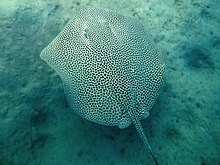Himantura
| Himantura | |
|---|---|

| |
| Reticulate whipray (H. uarnak) | |
| Scientific classification | |
| Domain: | Eukaryota |
| Kingdom: | Animalia |
| Phylum: | Chordata |
| Class: | Chondrichthyes |
| Subclass: | Elasmobranchii |
| Order: | Myliobatiformes |
| Family: | Dasyatidae |
| Subfamily: | Urogymninae |
| Genus: | Himantura J. P. Müller & Henle, 1837 |
| Type species | |
| Raja sephen uarnak J. F. Gmelin, 1789
| |
Himantura is a genus of stingray in the family Dasyatidae that is native to the Indo-Pacific. In a 2016 taxonomic revision, many of the species formerly assigned to Himantura were reassigned to other genera (Brevitrygon, Fluvitrygon, Maculabatis, Pateobatis, Styracura and Urogymnus).[1]
Species
There are four valid species:[2]
- Himantura australis Last, White & Naylor, 2016 (Australian whipray)
- Himantura leoparda Manjaji-Matsumoto & Last, 2008 (Leopard whipray)
- Himantura uarnak (J. F. Gmelin, 1789) (Reticulate whipray)
- Himantura undulata (Bleeker, 1852) (Honeycomb whipray)
A fifth species, Himantura tutul (fine-spotted leopard whipray), has been described,[3] but its validity has been disputed [4] and it is somewhat arbitrarily considered a junior synonym of H. uarnak by the Catalog of Fishes.[2] The Catalog of Fishes chose to synonymize H. tutul with H. uarnak, despite the fact that H. tutul was previously confused not with H. uarnak, but with H. leoparda, and subsequently shown to be reproductively isolated from both H. uarnak and H. leoparda.[5][6] While adult H. uarnak typically present solid spots only, both adult H. leoparda and H. tutul are distinct from it by the presence of leopard-like ocellated spots, which are smaller and less numerous in H. tutul.[3][5][6]
References
- ^ Last, P.R.; Naylor, G.J.; Manjaji-Matsumoto, B.M. (2016). "A revised classification of the family Dasyatidae (Chondrichthyes: Myliobatiformes) based on new morphological and molecular insights". Zootaxa. 4139 (3): 345–368. doi:10.11646/zootaxa.4139.3.2. PMID 27470808.
- ^ a b Eschmeyer, W.N.; R. Fricke; R. van der Laan (24 April 2018). "Catalog of Fishes". California Academy of Sciences. Retrieved 24 April 2018.
- ^ a b Borsa, P.; Durand, J.-D.; Shen, K.-N.; Arlyza, I.S.; Solihin, D.D.; Berrebi, P. (2013). "Himantura tutul sp. nov. (Myliobatoidae, Dasyatidae), a new ocellated whipray from the tropical Indo-West Pacific, described from its cytochrome-oxidase I gene sequence" (PDF). Comptes Rendus Biologies. 336 (2): 82–92. doi:10.1016/j.crvi.2013.01.004. PMID 23608177.
- ^ Weigmann, S. (2016). "Annotated checklist of the living sharks, batoids and chimaeras (Chondrichthyes) of the world, with a focus on biogeographical diversity". Journal of Fish Biology. 88 (3): 837–1037. doi:10.1111/jfb.12874. PMID 26860638.
- ^ a b Arlyza, I.S.; Shen, K.-N.; Solihin, D.D.; Soedharma D.; Berrebi, P.; Borsa, P. (2013). "Species boundaries in the Himantura uarnak species complex (Myliobatiformes : Dasyatidae)" (PDF). Molecular Phylogenetics and Evolution. 66 (1): 429–435. doi:10.1016/j.ympev.2012.09.023. PMID 23023209.
- ^ a b Borsa, P. (2017). "Comment on 'Annotated checklist of the living sharks, batoids and chimaeras (Chondrichthyes) of the world, with a focus on biogeographical diversity' by Weigmann (2016)" (PDF). Journal of Fish Biology. 90 (4): 1170–1175. doi:10.1111/jfb.13235. PMID 28026866.
